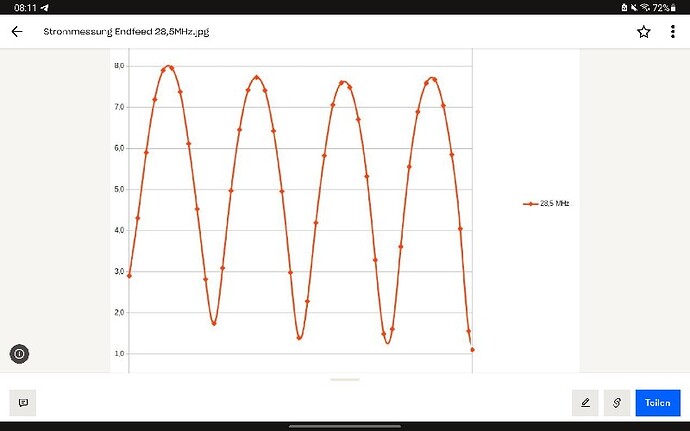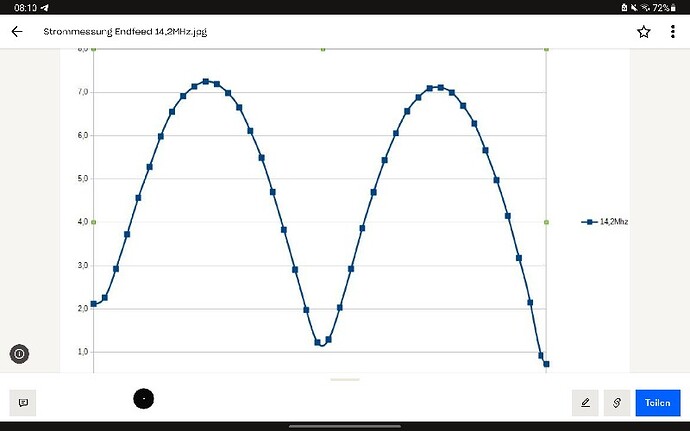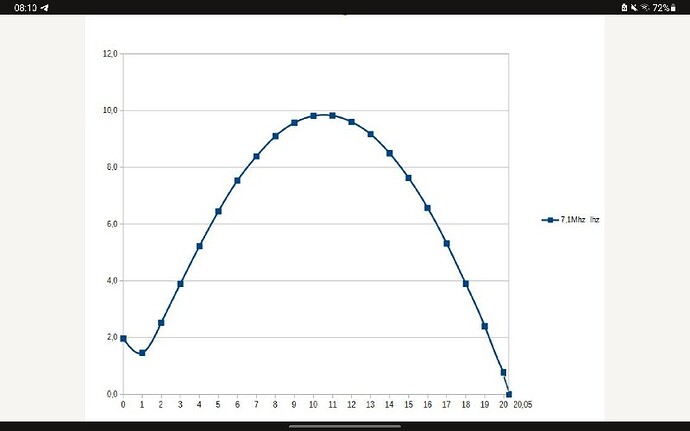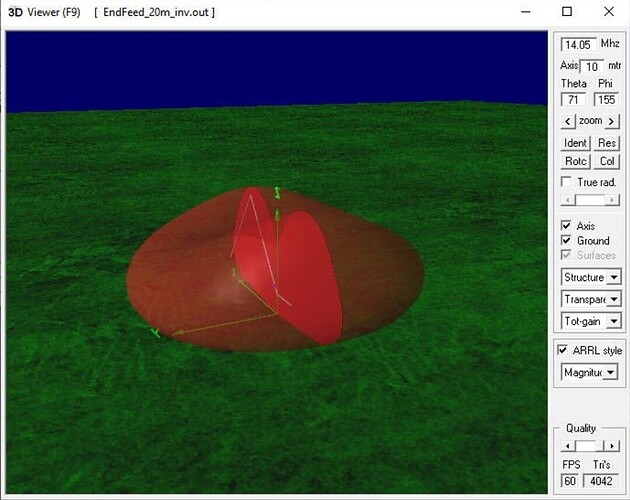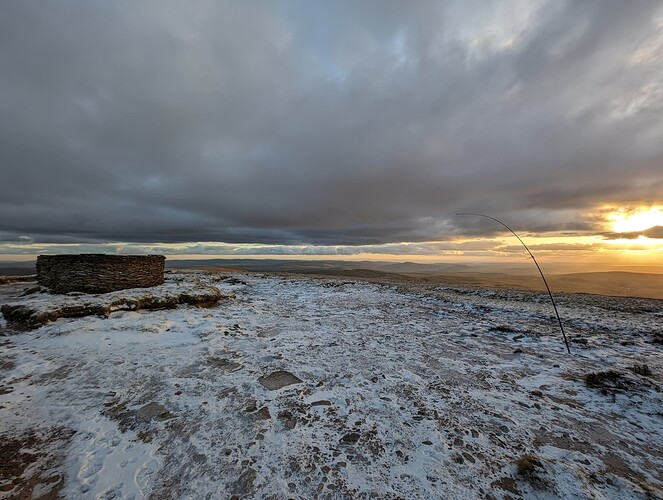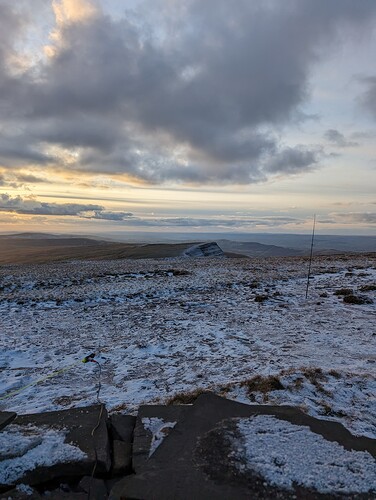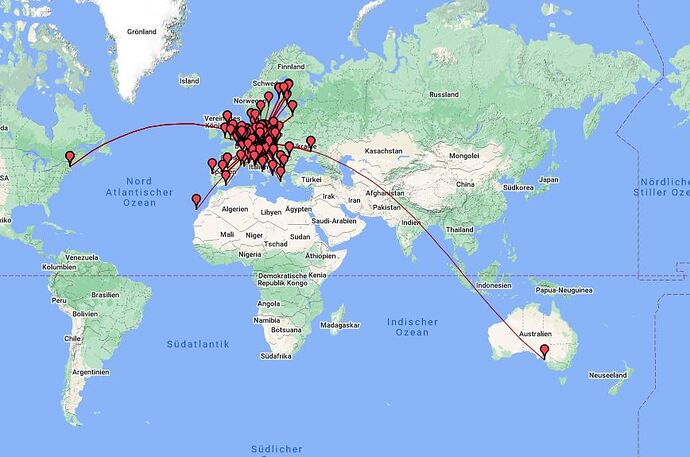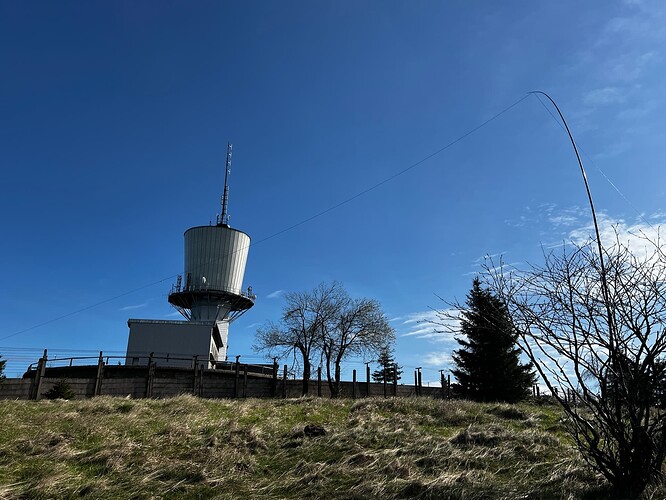I have used a QRP Multiband End-Fed-Half-Wave on some of my activations, normally in a “sloper” configuration. Although I have had some success, I have always had one question that I thought I would present to the group - from practical field experience, is there a benefit to elevating the transformer end of the antenna versus the other way around? I have normally run it with the transformer close to the radio to reduce the length of feed line I have to carry, but an older ham in my club told me I was probably transmitting a lot of my energy into the ground, especially when operating on 10 meters. Any insight you can offer would be greatly appreciated.
Hi Chris. That’s a good question. If I have trekking poles with me I generally elevate the feedpoint and run 5m of rg-174 coax back to the radio. On various occasions I’ve forgotten my poles or the coax. If there isn’t a handy bush to sit the feedpoint in, then it goes on the ground. If I forget the coax, then the 49:1 goes straight in the radio. It just works.
The 40m EFHW isn’t optomised for 10m. It is two wavelengths long at 28MHz and the radiation pattern is full of lobes and nulls. This hasn’t stopped me working California from Scotland with my one. 10w SSB. I wouldn’t sweat it too much.
I run my EFHW in an inverted L configuration. Initially the 49:1 unun was on the ground - concrete. I did raise it to about 3 - 4 feet out of concern for being ‘too close to ground.’ Did not discern any difference in signal reports, noise or directionality. And yes, not a great performer on 10M…but typically ‘adequate.’
I can’t boast many EU contacts with it, but do gt some. My QTH of California does allow great paths to Asia, Russia and some south pacific islands.
My activator philosophy: I accept my temporary on-summit antenna setups will compromise performance somewhat for small weight & packed volume and speed & ease of deployment.
For many years I used my EFHWs (40/30/20 and 40/20/10) as slopers, fed either at top of mast (via 10m of RG714 coax) or bottom end (elevated by bush or rock if possible) via 2m of coax and got good results with 10W CW (judged by reports received and given) using either feed point, e.g. N/American QSOs on 10m last October….
After many reflector bloggers praised the inverted-L EFHW configuration over slopers, I switched to inverted-L with feed point at the bottom of the pole (with 2m coax to rig). I get very good results but – without doing an A vs B comparison (which I can’t do as I don’t have two identical EFHWs) – and with so many confounding variables - I honestly can’t tell if there’s an improvement over the slopers.
I did compare the EFHW inv-L vs my Cha MPAS Lite vertical. Neither was clearly better than the other although the former ‘won on points’. The vertical when used with my KX2/int-ATU has many good features (robustness, ease of deployment, small footprint) so I still use it a lot, e.g, when doing 30m and 10m.
IMO: unless you are contesting or chasing rare Dx:
- Feed your EFHW at the wire end that’s convenient for you
- [To paraphrase that much-quoted saying] your best antenna is the one you packed. I like to pick and choose for each occasion
Hello Chris.
My method for the EFHW is inverted V setup.
At the 49 t 1 end or near where you want to sit has 3m of cord which I run though the strap on the hand piece of my walking pole. The pole is extended to its limits in length and jammed in the rocks or against something to keep it vertical. That cord is then pulled out like a tent support tight as I can get it. On the far end is 4m of cord that is pullout to tighten the antenna and load up my 6m pole which helps keep it up in the air and not collapse down. My tie off plastic fitting is a piece of zip tie with string on it to tie to the pole but has a hole in it and it can float along the antenna wire and not fixed in one position on the antenna wire. The reason for that is sometimes on summits its not possible to set it up in the same inverted V shape and if the wire can float thought the tie off point on the mask it sets up easiest for different summit locations. My coax is 2m of RG174 soldered directly to the 49 T1 with a BNC on radio end and a small ferrite with 6 turns through it and held with heat shrink a few inches from the radio feed point. I first set up my antennas in my yard and chase other SOTA ops with it to test it and then I know it will work when I go out myself on summits. My last SOTA netted me 30 QSO with 8w from the KX3 on 40 20 15 10m SSB and CW. VK ZL EU JA.
I personally think the inverted V works better than an inverted L with only 1 pole on a summit set up, unless you had a tree for support on most summits to get your far end up to make the true L shape. The vswr would vary too from set up as a inv V compared to inv L judging from my experiments in my yard with the two config’s.
Regards all
Ian vk5cz …
I run a 40 meter EFHW using a Sparkplug Antenna transformer. Almost always an inverted “V”, and I use a 25 foot run of RG-174 from the transformer back to the KX2. Six meter SOTA beam carbon fiber mast holding it up. It has always worked well for me whether the feed point is on the ground or hanging in a bush or tree (or something). I’m not very technically inclined–more of “if it works, it works” kind of operator–but have had great success running 5 watts CW from the high deserts and mountains of Eastern California. F4WBN regularly chases me (not unusual, of course), and JA’s are pretty common. Got Indonesia once . . .
Chris,
As it is a half wave or multiples thereof it doesn’t matter which end is closest to the ground. It’s symmetrical.
Having the coax feed at the high end will induce common mode currents on the feeder and distort the pattern.
I think having the feed point closer to the ground is the better option as it minimises the length of coax required. My construction specifically avoids any currents on the outside of the coax.
Like Ian I use an inverted Vee arrangement as the availability of a convenient tree isn’t guaranteed but taking a squid pole fixes that.
Also more importantly it gets the 40 m current maxima up as high as possible.
Yes the radiation pattern goes to pot on the higher frequencies but in the inverted Vee configuration there is some vertical polarisation and some filling in of the nulls.Thr same applies for the sloper set up.
73
Ron
VK3AFW
Yes, the high-frequency current is symmetrical, as my measurements have confirmed.
The greater the current in the antenna wire, the higher the energy radiated.
An inv V brings the current maximum up on 40m , and produces an almost non-directional and flat radiation on 20m.
73 Chris
Nice Graphics Chris.
Good to get an independent input on the topic.
73
Ron
VK3AFW
Confirming Ron and others comments
I use a 40/20 inverted vee and 40 it gets out better than a end fed wire
John ve3ips
I use a sloping inverted L EFHW. The transformer is attached with a velcro strap about 1m from the bottom of the pole. The wire goes up the pole and then out. The far end has about 2m of nylon cord and is pegged on the ground. I’ve not tried any other combination but this is easy to set up and seems to be effective.
73 Richard
I place Balum half a meter off the ground. This helps with the “ground” effect
I’ve always made a lot of contacts, especially in the 10 meters and I don’t use “counter poise”. There is a toroid 2 meters from the radio output, in the coaxial cable, wound 3 times (RG 174)
73
Carlos
PY2VM
First and foremost thanks for all the replies and the great input. Sounds like an inverted V with a short feed line may be the consensus. I will definitely try this out on my next outing (or maybe in the backyard) and let you know. Thanks again!
My inv-L is set up the same, Richard, except the far end is two metres above ground. What I can’t remember is whether there is a null 180 degrees away from the direction of the horizontal component. Any ideas on that?
Elliott, K6EL
No. I’ve not noticed any obvious directionality but I’ve never looked. The alignment of the wire is always determined by the hill, footpaths, vertical drops etc so I just set it up however seems best and it always seems to work. For the DX S2S days I’ve taken part in I use a vertical so it’s omnidirectional.
73 Richard
The end of a HALF-wave has zero current, and current remains low for some distance. It being close to the ground is not noticeably lossy.
For your curiosity, here is how I have deployed an EFHW for a thousand activations: Wire is an inverted-L. I tape the wire to the fishing pole about five feet up and about three feet from the end of the wire. The wire then goes up to the tip-top, then out more or less horizontally, secured to a bush. The loose pole end plugs into a 64:1 impedance transformer which in turn is plugged directly into the radio. There is no coax, no feedline, nothing to uncoil, coil, carry, or be additional loss.
Deploying as a sloper from the top of the fishing pole toward ground has several disadvantages. The length of wire being supported by the pole is some fifteen feet longer than deploying as an inverted-L. The area of maximum radiation is in the middle, and that is much lower deployed this way. With an inverted-L and depending upon which band is being discussed, maximum current may be split between the highest part of the vertical and the highest part of the horizontal.
Best QRP DX with this antenna was another QRP station, 11,000 miles away, /MM in the Indian Ocean.
73, fred KT5X / WS0TA
I have run a sloper with the feed point at its closest, elevated a few centimeters from the ground. At its closest, it’s on my backpack on the floor. The best case was, I think, a summit shelter on Fan Brycheiniog (pictured).
I generally use EFHW for 40m up in an inverted V config as this can be easily deployed with a single guy rope. However, some summits I’ve been on don’t have a whole lot of room, so a 20m sloper EFHW is a good compromise, if not a little risky perhaps.
The key point I wanted to come in and make here is likely something everyone has had happen. My antenna fell down twice recently during WB activations, and both times I failed to notice, as I had my head in a small tent. I did notice the signal reports drastically drop; however, I carried on working stations, many of which were perfectly audible, with the wire simply laying on the ground.
So in terms of efficiency, there is a difference im sure, but when I can still work stations around Europe with the antenna laying on the deck, I’m not sure I’ll ever have the patience to measure or notice a difference in feed point height differences. I definitely am not a purist or a perfectionist; I’m a “get the job done” kind of guy. One day I’ll probably go and spend some time on a summit to try to not be such a speed demon. I’m sure the chasers probably hate me! just thought I’d chip in.
I use my 20m long endfeed as INV V configuration. I take the balun 1-2m above the ground and the end too. For working on 30/60m I put a additional 10m wire to the end of the antenna. I only use 5 watts in ssb/cw and worked 108 dxcc from my poratable activations in the last 5 years.
this was my yesterday log (5 summits 1x SOTA , 4 GMA).
In summer I will compare the configuration of the 20m EFHW in INV V, INV L and for sloper with wspr… I think the configuration is depending also from the bands… 73 dl7cx/ok8cx
p.s. The losses due to poor ground are very low in the antenna due to its nature.
yesterday at OK/KA-013 Dylen
So, in summary. They work. DX when the bands are good. Use it how you wish. Inverted V, sloper, inverted L sloping, almost vertical up a big tree. Coax, no coax. Remember ground conditions vary from hill to hill too.
To throw something else in there, my latest EFHW uses a 64:1 with a better torroid and a 40cm shorter wire to compensate. I also try and use less lossy coax on 10m. Coax is essential in the Scottish winter. It allows me to hide and keep the abtenna in the open. So, more efficient coax and torroid.
Of course, none of us have done A/B tests, so there’s no science in this thread anyway. (Along comes @HB9EAJ Stephan ![]() .)
.)
Yes indeedy! Once again [like every time an antenna question come up on this reflector] pretty much everyone gets decent - albeit not ideal - results (except when hit with a propagation problem) citing what they use from a wide range of available antenna types and physical configurations.
Which is why my choice for a particular activation - from my collection of inverted-V linked dipoles, inverted-L / sloper EFHWs, bottom-fed vertical antennas - is often based on target bands, summit topology (if I know it), weather, time of day but often a whim (I just fancy taking the one that’s gathering dust).
